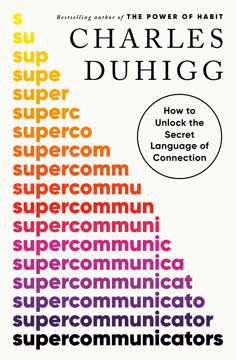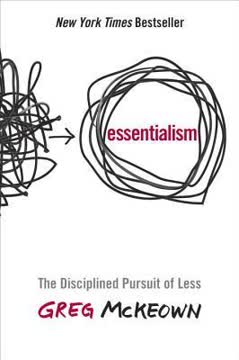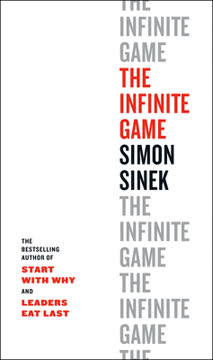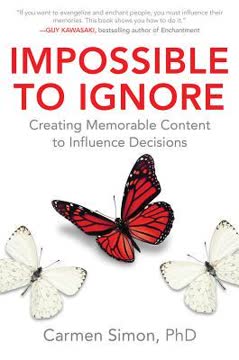Key Takeaways
1. Memory is a means to an end: People act on what they remember
People act on what they remember, not on what they forget.
Adaptive behavior. Memory serves as the fuel for the brain's prediction engine. Our ability to accurately anticipate future outcomes and make optimal decisions is rooted in our capacity to recall past experiences. This evolutionary advantage allows us to navigate complex environments efficiently.
Future-focused memory. Rather than simply recollecting the past, memory primarily functions to inform future actions. When creating content, consider how it will influence your audience's future decisions and behaviors. Frame information in a way that highlights its relevance to upcoming choices or challenges.
Key memory drivers:
- Reflexes (automatic responses)
- Habits (learned behaviors)
- Goals (conscious intentions)
2. Prospective memory: The key to influencing future actions
You are a choreographer of delayed intentions.
Three-step process. Prospective memory, or remembering to act on future intentions, involves three critical steps: noticing cues, searching memory, and executing intentions. By designing content that facilitates each of these steps, you increase the likelihood of your audience taking desired actions in the future.
Reward-driven action. People are more likely to follow through on intentions when they perceive a clear reward. When crafting your message, emphasize the benefits of taking action and how it aligns with your audience's goals or values. Consider both immediate and long-term rewards to appeal to different motivations.
Factors influencing prospective memory:
- Strength of cue-intention association
- Perceived importance of the task
- Timing and context of the cue
- Emotional significance
3. Control what your audience remembers to avoid random recall
Unless we take control of the metaphorical 10% message, an audience will remember things at random.
The forgetting curve. Research shows that people typically forget up to 90% of new information within days of exposure. To combat this, focus on creating a clear, concise "10% message" – the essential information you want your audience to retain.
Verbatim vs. gist memory. Consider whether you need your audience to remember exact details (verbatim memory) or just the general idea (gist memory). Tailor your content accordingly, using repetition and elaboration for verbatim recall, or focusing on overall concepts for gist memory.
Strategies for controlling recall:
- Use distinctive visual or auditory elements
- Create meaningful associations with existing knowledge
- Employ spaced repetition techniques
- Engage multiple senses in your presentation
4. Cues pave the way to action: Design for attention and recall
You may be only as memorable as your cues.
Automatic attention. Leverage the brain's natural tendency to notice certain stimuli automatically. Use physical properties like color, size, motion, or sound to make your key points stand out. This helps ensure that important information captures attention even when your audience is distracted.
Habit-based cues. Connect new information to existing habits or routines. This makes it easier for your audience to incorporate your message into their daily lives. For example, if introducing a new software feature, show how it integrates seamlessly with tools they already use.
Types of effective cues:
- Visual: Unique images, infographics, or icons
- Auditory: Distinctive sounds or music
- Contextual: Environmental triggers
- Emotional: Stimuli that evoke strong feelings
- Goal-related: Reminders of personal objectives
5. The paradox of surprise: Balancing predictability and novelty
Surprise is a prediction error.
Biological response. Surprise triggers a rapid, automatic response in the brain, followed by a slower, evaluative process. This dual reaction can be leveraged to capture attention and enhance memory formation. However, too much surprise can be unsettling, so balance is key.
Expectation management. People derive pleasure from accurate predictions, but also enjoy some level of novelty. Create content that meets some expectations while introducing unexpected elements. This approach satisfies the brain's desire for both familiarity and new information.
Techniques for effective surprise:
- Break established patterns or schemas
- Introduce familiar concepts in novel contexts
- Use visual or conceptual juxtaposition
- Subvert common assumptions or beliefs
- Reveal unexpected connections between ideas
6. Sweet anticipation: Building excitement for what happens next
Anticipation is acting on expectations.
Dopamine's role. Anticipation triggers the release of dopamine, a neurotransmitter associated with motivation and reward-seeking behavior. By creating a sense of anticipation, you can increase engagement and the likelihood of future action.
Balancing certainty and uncertainty. Provide enough information to create clear expectations, but leave some aspects uncertain to maintain interest. This approach taps into the brain's natural curiosity and desire for reward prediction.
Elements of effective anticipation:
- Clear timeframes for expected outcomes
- Gradual reveal of information
- Foreshadowing of future benefits or challenges
- Interactive elements that allow audience participation
- Storytelling techniques that build suspense
7. Crafting repeatable messages for lasting impact
Repeatable messages are aspirational.
Portability. Create messages that can be easily applied in various contexts. This increases the likelihood of recall and sharing. For example, "A picture is worth a thousand words" is memorable because it can be used in numerous situations.
Universal appeal. Tap into widely recognized values or experiences to make your message resonate with a broad audience. This approach increases the social currency of your content, making people more likely to repeat and share it.
Characteristics of repeatable messages:
- Simple syntax
- Distinctive word choice
- Emotional resonance
- Relevance to long-term goals
- Generic enough to apply broadly
- Specific enough to be meaningful
8. Distinctiveness: The secret to staying on people's minds
To perceive distinctiveness, we must perceive similarity.
Isolation effect. Items that stand out from their surroundings are more likely to be remembered. Create contrast in your content by varying elements like color, size, or conceptual framing. This helps key points become more salient and memorable.
Breaking patterns. Establish a pattern in your content, then strategically break it to create distinctiveness. This approach leverages the brain's tendency to notice deviations from expected norms.
Ways to achieve distinctiveness:
- Use unexpected metaphors or analogies
- Employ visual contrast in design elements
- Introduce opposing viewpoints
- Share unique personal experiences
- Combine seemingly unrelated concepts
9. The science of retrieving memories through storytelling
We may not remember what we experienced, but we remember what we understood.
Multi-dimensional encoding. Effective stories engage multiple brain regions by incorporating sensory details, emotions, and abstract concepts. This creates a richer memory trace, making the information easier to retrieve later.
Personal relevance. Craft stories that allow your audience to see themselves in the narrative. This increases engagement and makes the content more memorable by connecting it to personal experiences and emotions.
Key elements of memorable stories:
- Vivid sensory details
- Clear sequence of events
- Emotional engagement
- Relatable characters or situations
- Meaningful takeaways or lessons
10. Optimizing content quantity for maximum retention
Short feels good but is not always memorable.
Balancing brevity and depth. While concise messages are often easier to process, they may not provide enough context for long-term retention. Find the right balance between brevity and elaboration based on your communication goals and audience needs.
Chunking information. Break complex ideas into smaller, manageable units. This approach makes information easier to process and remember while still allowing for comprehensive coverage of a topic.
Strategies for content optimization:
- Use hierarchical organization
- Provide clear transitions between concepts
- Employ visual aids to summarize key points
- Repeat crucial information in different formats
- Allow time for reflection and processing
11. Understanding the neurobiology of decision-making
Mere knowledge about a reward is not motivation.
Value-based choices. The brain assigns value to different options based on past experiences, anticipated rewards, and perceived effort. When creating persuasive content, focus on clearly communicating the value proposition and addressing potential concerns.
Automatic vs. deliberate decisions. Recognize that some decisions are made quickly and automatically, while others require more conscious deliberation. Tailor your approach based on the type of decision you're trying to influence.
Factors influencing decisions:
- Perceived effort required
- Time delay before receiving rewards
- Risk assessment
- Social impact of the choice
- Emotional state during decision-making
12. The right to be forgotten vs. the intent to be remembered
Does the memory for your content have an expiration date?
Digital permanence. In today's interconnected world, information can persist indefinitely online. Consider the long-term implications of your content and how it might be perceived in different contexts or time periods.
Purposeful forgetting. Sometimes, it's beneficial for audiences to forget outdated information or practices. When introducing new ideas or processes, actively address why previous approaches are no longer relevant and how the new information supersedes them.
Balancing remembering and forgetting:
- Regularly update and refresh key content
- Provide context for how information evolves over time
- Offer clear guidance on what should be retained vs. discarded
- Create content with long-term relevance in mind
- Be prepared to adapt messaging as circumstances change
Last updated:
FAQ
1. What’s Impossible to Ignore: Creating Memorable Content to Influence Decisions by Carmen Simon about?
- Focus on memorable content: The book explores how to create content that sticks in people’s memory and influences their decisions, emphasizing that people act on what they remember, not what they forget.
- Science-based approach: Carmen Simon draws on neuroscience and cognitive psychology to explain how memory works and how it can be harnessed for business, marketing, and communication.
- Practical application: The book translates complex memory research into actionable techniques for professionals who want to make their messages impossible to ignore and more likely to drive action.
2. Why should I read Impossible to Ignore by Carmen Simon?
- Influence decisions effectively: The book teaches how to craft messages that are memorable enough to drive future actions, a critical skill in today’s noisy and competitive environment.
- Leverage brain science: Readers gain insights into attention, memory, and decision-making processes, helping them create content that truly resonates and stands out.
- Gain practical tools: The book offers concrete methods and real-world examples for controlling what audiences remember, using cues, surprise, and anticipation to spark action.
3. What are the key takeaways from Impossible to Ignore by Carmen Simon?
- Memory drives action: People act on what they remember, so communicators must design content with memory in mind.
- Fifteen controllable variables: The book identifies 15 variables (like context, cues, emotion, novelty, and repetition) that can be combined to make content more memorable.
- Balance and context matter: Effective content uses the right mix of these variables, tailored to the audience and communication goals, rather than relying on a single factor.
4. What are the best quotes from Impossible to Ignore by Carmen Simon and what do they mean?
- “People act on what they remember, not on what they forget.” This highlights the central thesis that memory is the gateway to influencing decisions.
- “Memory is not just about the past; it’s about predicting and preparing for the future.” This reframes memory as a tool for future-oriented action, not just recall.
- “Surprise is a prediction error.” This quote explains how unexpected elements can capture attention and enhance memory by violating expectations.
5. What are the 15 controllable variables that influence memory in Impossible to Ignore by Carmen Simon?
- Comprehensive list: The variables are context, cues, distinctiveness, emotion, facts, familiarity, motivation, novelty, quantity of information, relevance, repetition, self-generated content, sensory intensity, social aspects, and surprise.
- Strategic combination: The book emphasizes using these variables in the right proportions, not just focusing on one.
- Context-dependent application: Different communication goals may require different dominant variables, and the book provides guidance on tailoring them accordingly.
6. How does Impossible to Ignore by Carmen Simon explain the role of memory in decision-making?
- Memory as prediction: The brain uses memory to predict future rewards and guide behavior toward maximum benefit.
- Three routes to action: Decisions are influenced by reflexive (Pavlovian), habitual, or goal-oriented memory pathways, each requiring different content strategies.
- Prospective memory focus: Remembering to act on future intentions (prospective memory) is key to influencing decisions beyond simple recall.
7. What is the prospective memory model in Impossible to Ignore by Carmen Simon and why is it important?
- Three-step process: The model involves noticing cues, searching memory for related information, and executing the action if it’s rewarding enough.
- Business application: Communicators can design content that primes audiences at Point A to remember and act at Point B.
- Reward-driven behavior: Motivation and perceived reward at each step are crucial for turning memory into action.
8. How does Carmen Simon advise controlling what your audience remembers in Impossible to Ignore?
- Focus on the 10% message: Since most information is quickly forgotten, identify and control the critical 10% you want audiences to retain.
- Balance verbatim and gist memory: Decide whether you want audiences to remember exact details or the general meaning, as each serves different purposes.
- Prevent random memory: Use distinctiveness, repetition, and cues to ensure key messages stick and avoid audiences remembering information at random.
9. What role do cues play in making content memorable according to Impossible to Ignore by Carmen Simon?
- Cues attract attention: Distinctive physical properties and habitual associations help cues stand out and trigger memory automatically.
- Link cues to intentions: Effective cues must be strongly connected to the intended action and relevant to the audience’s goals.
- Internal and external cues: Reflective attention cues, such as questions or prompts, can deepen memory encoding by directing internal thought.
10. How does Impossible to Ignore by Carmen Simon describe the paradox of surprise in memory and attention?
- Surprise as prediction error: Surprise occurs when expectations are violated, triggering heightened attention and emotional engagement.
- Balance predictability and novelty: Combining familiar schemas with unexpected elements creates pleasant surprises that sustain interest.
- Dopamine and motivation: Positive surprises release dopamine, enhancing motivation, memory encoding, and the likelihood of action.
11. What is the significance of anticipation and dopamine in Impossible to Ignore by Carmen Simon?
- Anticipation fuels motivation: Expecting a reward activates dopamine pathways, increasing focus, learning, and the drive to act.
- Create “sweet anticipation”: Using imaginative language and managing uncertainty can build excitement and sustained attention.
- Balance certainty and novelty: Mixing predictable elements with novel surprises optimizes dopamine release and keeps audiences engaged.
12. How does Impossible to Ignore by Carmen Simon address the right to be forgotten versus the intent to be remembered?
- Forgetting can be accidental or purposeful: Accidental forgetting happens when information isn’t encoded or decays, while purposeful forgetting is needed to replace old routines or beliefs.
- Digital permanence: The book discusses challenges with digital content, such as the European “right to be forgotten,” and the reality that online information may persist indefinitely.
- Plan for future disruptions: To remain memorable, content must be part of the audience’s future context, and communicators should anticipate disruptions that could affect memory and decision-making.
Review Summary
Impossible to Ignore receives mixed reviews, with an average rating of 3.79 out of 5. Readers appreciate the book's insights on creating memorable content and influencing decisions, based on neuroscience and cognitive psychology. Many find the information useful for marketing, presentations, and communication. However, some criticize the dense, academic writing style, which can make it challenging to read. Despite this, many readers believe the book offers valuable techniques for improving content retention and audience engagement, making it a worthwhile read for those in business and marketing.
Similar Books










Download PDF
Download EPUB
.epub digital book format is ideal for reading ebooks on phones, tablets, and e-readers.





